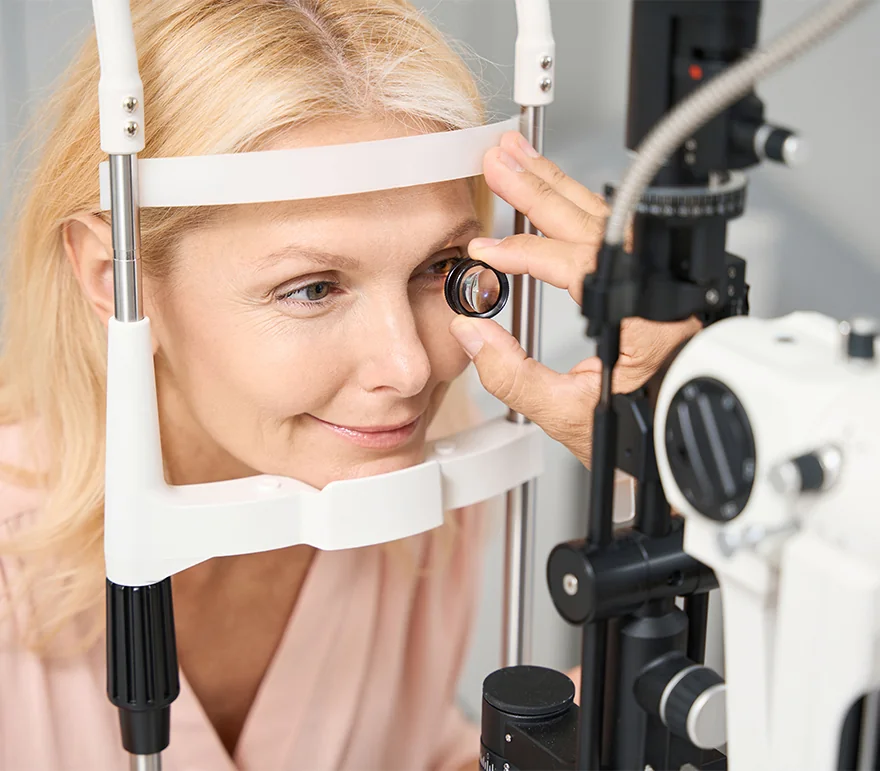
Laser Glaucoma Treatments
Glaucoma is an eye condition that causes damage to the optic nerve. There is no cure for glaucoma, but there are a number of treatments available and vision loss can be prevented when glaucoma is detected and
Trusted Source
What is Glaucoma?
American Academy of Ophthalmology
Go to Source
treated early
. There are several advanced laser treatments that can effectively treat glaucoma in order to protect your vision.
The eye doctors at Cincinnati Eye Institute are leaders in comprehensive eye care. Our experienced glaucoma specialists are experts in diagnosing and treating glaucoma. We provide each patient with a treatment plan that is custom-tailored to meet their needs, which may include one of several advanced laser treatment options:
Selective Laser Trabeculoplasty (SLT)
Selective laser trabeculoplasty, or SLT, is an FDA-approved laser procedure for the treatment of open-angle glaucoma. SLT is an advanced treatment option that increases fluid drainage and lowers eye pressure
Trusted Source
Chang DF
Samuelson, TW
Go to Source
by 35%
, on average. It is minimally-invasive and uses low levels of energy to selectively pinpoint the trabecular meshwork, lowering the eye pressure.
If needed, the procedure can be repeated several times without causing damage to surrounding tissue. SLT can control glaucoma symptoms for up to 5 years while also reducing or eliminating the need for glaucoma medication.

Endocyclophotocoagulation Laser (ECP)
Endocyclophotocoagulation laser treatment (ECP) is a minimally invasive laser procedure that aims to decrease fluid production with the goal of lowering intraocular pressure. ECP uses a specialized laser that can be used in combination with cataract surgery. The ECP laser directs energy to the part of the eye that produces fluid in order to decrease fluid production.
Laser Peripheral Iridotomy (LPI)
Laser peripheral iridotomy, also known as LPI, is a laser procedure used to lower eye pressure in patients with narrow-angle glaucoma, and reduce the risk of narrow angle glaucoma in certain patients. Narrow-angle glaucoma is a condition that occurs when the angle between the iris and the cornea in the eye is too small, resulting in a blockage of fluid in the drainage channel of the eye. Using a laser, a small hole is made in the iris to increase the angle between the iris and cornea allowing fluid to drain from the eye.
Preparing for Your Laser Glaucoma Treatment
A consultation appointment is the first step in any treatment plan. When you meet with your CEI eye doctor, we will take time to evaluate your eyes, as well as discuss your medical history and lifestyle in order to decide if you are a candidate for laser glaucoma treatment. If SLT, ECP or LPI are right for you, we will give you pre-procedure instructions.

What Happens During Laser Glaucoma Treatment
Laser glaucoma treatment is an outpatient procedure. You will be given anesthetic eye drops to numb your eyes. The details of the procedure will depend on which type of laser treatment you are having. In general, laser glaucoma procedures are completed quickly and painlessly.
Recovery After Laser Glaucoma Treatment
Immediately after your procedure, you may experience some mild sensitivity or temporary blurriness. Most patients can get back to regular activities the day after their procedure. Your doctor will discuss which medications you need to take and you will be scheduled for follow up appointments to check your eye pressure.
Contact Cincinnati Eye Institute for Laser Glaucoma Treatment
At Cincinnati Eye Institute, we are dedicated to caring for your vision and eye health. Contact us to schedule a consultation or learn more about laser glaucoma treatment options.
1 American Academy of Ophthalmology. What is Glaucoma? Available: https://www.aao.org/eye-health/diseases/what-is-glaucoma. Accessed September 30, 2020.
2 Samuelson, TW. Chang DF. Marquis, R. A Schlemm Canal Microstent for Intraocular Pressure Reduction in Primary Open-Angle Glaucoma and Cataract. Ophthalmology. January 2019 Volume 126, Issue 1, Pages 29–37
The doctors at Cincinnati Eye Institute have either authored or reviewed the content on this site.





















































































